6 Setting Up SPMS Desktop Application Clients
The SPMS Application Clients can be installed on any machines installed that has the full Oracle Client including the ODAC component.
Prerequisites
-
Ensure that the Microsoft .NET Framework 2 and 3.5 are turned on in Window Features before installing Oracle Full Client and OHC_SPMS_V20.1 SETUP.exe.
-
Oracle 12c Database client with ODAC is installed on the target machine. See topic Oracle Database Client and ODAC Installation.
-
SPMS 20.1 Installer is downloaded and available in the target machine. See topic SPMS Installation File for download instructions.
-
SPMS 20.1 Package is downloaded and available in the target machine. See topic SPMS Package File for download instructions.
-
Ensure that the Windows Regional and Language Settings on the target machine is configured to US/UK and the language settings is set to English. This important to ensure that you get the expected SPMS functionality.
SPMS Desktop Application Clients Installation Steps
Install using the Single Batch File
SPMS Application Client can be installed by running a command and left unattended until it completes the installation. Follow the instructions below to install the SPMS Application Client.
-
Download both the SPMS Installer. See topic Where to download to prepare the SPMS 20.1 Application Client Installation Package.
-
To prepare the SPMS 20.1 Application Client Installation Package, copy the SPMSClientInstall folder from the SPMS Package to the
C:\Tempfolder.Figure 6-1 SPMSClientInstall Folder SPMS Package

-
Copy the SPMS Installer (OHC_SPMS_V20.1Setup.exe) file to the
C:\Temp\SPMSClientInstall\Installersfolder.Figure 6-2 SPMS_V20.1SETUP in SPMSClientInstall

-
Now, you can copy the SPMSClientInstall folder to other target machines in order to run the unattended one-step installation.
Note:
You will only need to prepare the SPMS 20.1 Application Client Installation Package once. Once you have the package ready, you can remotely copy the package to any target machine and run the one-step SPMS Application Client installation remotely.
-
You can start the unattended one-step installation of the SPMS Application Client by navigating to the
C:\Temp\SPMSClientInstall\folder. -
Run the InstallSPMSApplications.bat using the Windows Administrative privilege by right-clicking the file and select Run as Administrator.
-
Once the installation starts, it can be left running unattended and you will only need to wait for it to complete.
Note:
If you intend to run both SPMS Application Client Version 7.0 / 7.30, and Version 8.0 / 20.1 or later on the same machine, you must disable the SPMS Version 7.0 / 7.30 FC Updater from running as it will interfere with the auto-registration of the SPMS DLLs by the Windows Scheduled Tasks.
-
To disable SPMS Version 7.0 / 7.30, just navigate to the SPMS Installed Folder for Version 7.0 / 7.30 and rename the FC Updater.exe file to FC Updater.exe.bak.
-
After installing the SPMS Application Client, a pair of Windows Scheduled Task is created to handle the SPMS DLLs registration automatically.
Figure 6-3 Created Task in Task Scheduler

Note:
The Windows Scheduled Task “OHC Hospitality Cruise SPMS 7.3 Registration” will auto-register SPMS components for SPMS Version 7.0 / 7.30 and below.
The Windows Scheduled Task “OHC Hospitality Cruise SPMS 8.0 Registration” will auto-register SPMS components for SPMS Version 8.0 / 20.1 and above.
Switching between SPMS Application Clients versions
-
When switching from SPMS Application Client for Version 7.0 / 7.30 to SPMS Application Client Version 8.0 / 20.1, the Windows Scheduled Task triggers the “Oracle Hospitality Cruise SPMS 8.0 Registration”, thus, registering the required SPMS DLLs automatically, using the Windows SYSTEM privilege.
-
Similarly, when switching from SPMS Application Client Version 8.0 / 20.1 to SPMS Application Client Version 7.0 / 7.30, the Windows Scheduled Task triggers the “Oracle Hospitality Cruise SPMS 7.3 Registration”, thereby, automatically register the required SPMS DLLs also by using the Windows SYSTEM privilege.
Switching to SPMS Application Client version 7.0 / 7.30
-
Run the FC Launch Panel of SPMS Version 7.0 / 7.30.
Figure 6-4 OHC Applications in Windows Explorer

-
Once launched, there will be a prompt as shown below notifying you that the SPMS DLLs registration process will take place. You are to wait for a next message prompt before proceeding to the next step.
Figure 6-5 Auto Registration Notification of SPMS 7.0/7.30
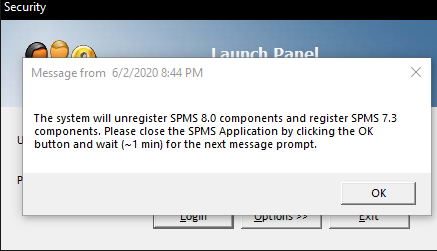
-
Once the DLL registration completes, a new message prompt will appear as shown below.
Figure 6-6 Completion of SPMS DLLs version 7.30 Auto Registration
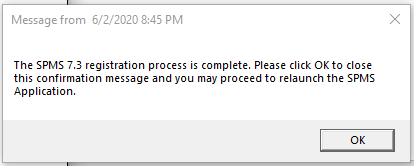
-
Follow the instructions in the message prompt and relaunch the FC Launch Panel for SPMS Version 7.0 / 7.30.
Note:
If you did not get the message prompts, we ask that you navigate to the folder
C:\tempDLLand check if the folder RegisteredSPMSv7_3 exist. -
If the folder RegisteredSPMSv7_3 exists, this means that the SPMS DLLs are registered successfully, and you can relaunch the FC Launch Panel for Version 7.0 / 7.30.
Switching to SPMS Application Client version 8.0 / 20.1
-
Run SPMS Version 8.0 OHC Launch Panel from Oracle Hospitality Cruise folder.
-
Once the program opens, you will receive a notification prompt that the registering of SPMS DLL will take place. Click OK and wait for a next message prompt before continuing.
-
You will receive a confirmation prompt once the registration process completes. Click OK to close the message, and proceed to relaunch the SPMS application.
-
Follow the instruction in the message prompt and relaunch the OHC Launch Panel for SPMS Version 8.0 / 20.1.
Note:
If you did not get the message prompts, we ask that you navigate to the folder
C:\tempDLLand check if the folder RegisteredSPMSv8_0 exist. -
If the folder RegisteredSPMSv8_0 exists as shown below, this means that the SPMS DLLs were successfully registered and you can relaunch the OHC Launch Panel for Version 8.0 / 20.1.
Figure 6-7 RegisteredSPMSv8_0 Folder

Loading DLLs from SPMS Allowlisted Path
This feature will prevent an unscrupulous party from performing a malicious attack on SPMS application through DLLs replacement. By default, SPMS will allow DLLs from:
-
C:\Windows,
-
C:\Program Files,
-
C:\Program Files (x86), and
-
C:\Oracle
Therefore, it is of utmost importance that you ensure the four folders above requires an Administrator level write access.
Should you intend to have an allowlist path other than the listed four, you should create an allowlist file (path.env) in the SPMS Installed folder C:\Program Files (x86)\Oracle Hospitality Cruise.
The format of the allowlist entry path is shown below. Each path is delimited with a semicolon character.
<AllowlistPath1>;<AllowlistPath2>;<AllowlistPathN>
You can refer to the SPMSClientInstall folder in the SPMS Package for a sample path.env file.
Connecting to different SPMS Database using different TNS
It is now possible for SPMS Application Client to easily connect to different SPMS Databases using different Database TNS Names by creating a new Database entry record to the local OHCSecurity.par file using a different Database TNS Name from the actual Database TNS Name used in the SPMS Database Server. With this, the SPMS Application Client can connect to the SPMS Database using a TNS Name different from the actual Database TNS Name used in the SPMS Database Server.
Adding New Database TNS to the Local OHCSecurity.par
-
Using the Windows Administrative privileges, run the command “OHC Tools.exe” /m. See Figure 4-6
-
On the OHC Tools Main screen, click the Create New Connection button to create a new Database entry in the local OHCSecurity.par file using a different Database TNS Name
-
The examples shown below will create a new DB TNS Name = FIDELIOTEST entry to the local OHCSecurity.par file for an existing DB TNS Name = FIDELIO connection.
Figure 6-8 SPMS Database TNS Creation Screen
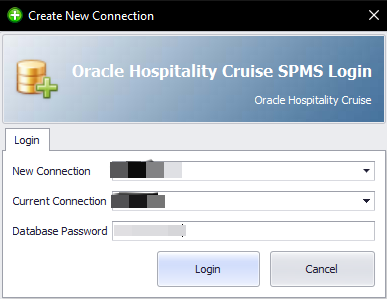
-
After clicking on the Login button, the SPMS User Authorization form is shown.
Figure 6-9 SPMS User Authorization Screen
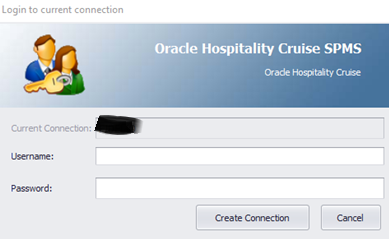
-
You need to authorize using the SPMS Login credential to create a new Database entry record to the local OHCSecurity.par file using a different Database TNS Name.
-
After the process completes, you can now connect to the same SPMS Database using the new Database TNS Name.
Figure 6-10 SPMS Launch Panel Login Screen
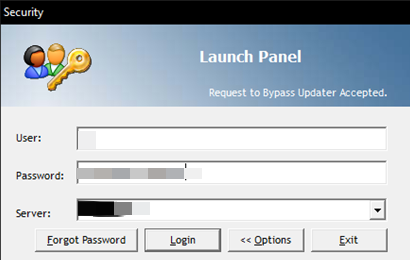
Uploading SPMS Applications or Libraries to Database
For the OHC Updater to automatically download the latest binaries or files on all SPMS Application Client machines, follow the instructions listed below to upload binaries or files to the SPMS Database.
-
Navigate to
C:\Program Files (x86)\Oracle Hospitality Cruisefolder and launch the Launch Panel and log in using a ‘Bypass Updater’, by holding down the ALT Key + click the female user icon. -
In the Launch Panel program, manually add these SPMS applications and DLL’s to the respective group by pressing F12 and select the group from the drop-down list.
-
For Utilities group:
-
OHC UpdaterWatchdog.exe
-
-
For System Files group:
-
OHCSPMSUI.dll
-
OHCWebSockets.dll
-
-
For REGASM Files group:
-
CRUFLFC.dll
-
OHCSPMSData.dll
-
OHCSPMSBusiness.dll
-
OHCSPMSMobile.dll
-
OHCSPMSUtils.dll
-
-
-
Additionally, on the Launch Panel, Utilities tab, update the Launch Panel, Updater and UpdaterAgent to the latest program file from the downloaded patch set, by right-clicking the program and selecting Properties, then click Update file and OK to save.
Downloading SPMS Applications or Libraries from Database
-
On the target SPMS Application Client machine, log in to Launch Panel without Bypass Updater to update all the programs.
-
A program UpdaterWatchdog is added to monitor and ensure the Updater remains active in the Task Manager, enabling the latest program to be downloaded from SPMS Database. If the Standard User is not able to connect to the Updater, reinstall the SPMS Application Client
See topic Install using the Single Batch File in SPMS Desktop Application Clients Installation Steps.
Converting Credit Card Payment from Non OPI to OPI Tokenization
-
Set up the OPI Manager. See topic OPI Shipboard Property Management System Installation Guide, Release 19.1 in Oracle Payment Interface 19.1.
-
Set up the OPI in SPMS. See topic the OPI Handling Guide at the Oracle Help Center.
-
Convert the existing credit card records to OPI Token at Get Token tab.
-
Select profile type and reservation to process.
-
Click the Start button to start the process.
-
Purge all OPI log files from
C:\Users\Public\Documents\Oracle Hospitality Cruisefolder.
-
Uninstalling SPMS Application Client
-
Open the Control Panel and select Programs, Programs and Features.
-
Select Oracle Hospitality Cruise SPMS from the program listed.
-
Click Uninstall on the menu bar.
-
Follow the instructions on the screen.
Troubleshooting
See Common errors in SPMS Desktop Application Client Installation.